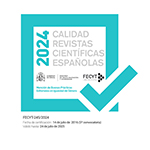La oposición oral/escrito: consideraciones terminológicas, históricas y pedagógicas
Abstract
This article aims at investigating the use of the terminology, the bases of the oral/griten opposition, the complementation and overlapping of these two modes of language. We begin with a terminological clarification and a review of the main research studies. Secondly, we delve into the pair orality vs. writing: distinctive and complementary features. Then, we describe oral marks in written texts and written marks in oral texts. We dedicate an extensive section to oral and written distinction in education. We pay special attention to the characteristics of oral and written form, oral genres, and narrators’ voices. Finally, we summarize the difficulties of teaching of the spoken mode of language.Cet article a pour ambition de mettre en évidence l'usage que l'on fait de la terminologie, les bases de l´opposition oral/écrit, la complémentarité et les chevauchements de ces deux modalités de la langue. Nous tacherons d´apporter quelques précisions terminologiques et de réviser les différentes approches proposées. On approfondit l´étude des relations entre l'oralité et l´écriture: distinction et complémentarité. On repère les traits de l´oralité dans les textes écrits et les traits de l´écriture dans les textes oraux. D´autre part, on consacre une ample section à l´oral et à l´écrit dans l'enseignement. De plus, on met en évidence les caractéristiques de la modalité orale et écrite: les genres oraux, les voix narratives. Finalement, on résume les difficultés d'enseignement de la modalité orale de la langue.
Downloads
Article download
License
In order to support the global exchange of knowledge, the journal Didáctica. Lengua y Literatura is allowing unrestricted access to its content as from its publication in this electronic edition, and as such it is an open-access journal. The originals published in this journal are the property of the Complutense University of Madrid and any reproduction thereof in full or in part must cite the source. All content is distributed under a Creative Commons Attribution 4.0 use and distribution licence (CC BY 4.0). This circumstance must be expressly stated in these terms where necessary. You can view the summary and the complete legal text of the licence.










